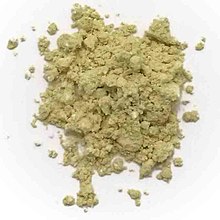Sodium bismuthate
 NaBiO3 powder.
| |
| Names | |
|---|---|
| Other names
Sodium bismuth oxide
| |
| Identifiers | |
3D model (
JSmol ) |
|
| ChemSpider | |
ECHA InfoCard
|
100.032.220 |
| EC Number |
|
PubChem CID
|
|
| UNII | |
CompTox Dashboard (EPA)
|
|
| |
| |
| Properties | |
| NaBiO3 | |
| Molar mass | 279.968 g/mol |
| Appearance | Yellow to yellowish-brown odorless powder[1] |
| Density | 6.50 g/cm3 |
| Insoluble in cold, decomposes in hot water[2] | |
| Hazards | |
| GHS labelling: | |

| |
| Warning | |
| H302, H315, H319, H335 | |
| P261, P264, P270, P271, P280, P301+P312, P302+P352, P304+P340, P305+P351+P338, P312, P321, P330, P332+P313, P337+P313, P362, P403+P233, P405, P501 | |
| Lethal dose or concentration (LD, LC): | |
LD50 (median dose)
|
420 mg/kg (rat, oral)[1] |
| Related compounds | |
Other anions
|
Sodium antimonate
|
Other cations
|
Potassium bismuthate |
Related compounds
|
Sodium hexafluorobismuthate(V) |
Except where otherwise noted, data are given for materials in their standard state (at 25 °C [77 °F], 100 kPa).
| |
Sodium bismuthate is an
A related compound with the approximate formula Na3BiO4 also exists.[5]
Structure
Sodium bismuthate adopts an ilmenite structure, consisting of octahedral bismuth(V) centers and sodium cations. The average Bi–O distance is 2.116 Å. The ilmenite structure is related to the corundum structure (Al2O3) with a layer structure formed by close packed oxygen atoms with the two different cations alternating in octahedral sites.[6]
Synthesis
Bismuth oxidizes to the +V oxidation state only with difficulty in the absence of alkali. Synthesis is performed by making a suspension of bismuth trioxide in a boiling sodium hydroxide solution. It is then oxidized by addition of bromine to form sodium bismuthate.[7]
- Bi2O3 + 6 NaOH + 2 Br2 → 2 NaBiO3 + 4 NaBr + 3 H2O
Another synthesis of NaBiO3 involves oxidizing a mixture of sodium oxide and bismuth(III) oxide with air (as the source of O2):[8]
- Na2O + Bi2O3 + O2 → 2 NaBiO3
The procedure is analogous to the oxidation of manganese dioxide in alkali to give sodium manganate.

Reactions
Storage conditions with moisture and high temperatures are detrimental to sodium bismuthate, as it oxidizes water, decomposing into sodium hydroxide and bismuth(III) oxide:[2]
- 2 NaBiO3 + H2O → 2 NaOH + Bi2O3 + O2
It is decomposed faster by
NaBiO3 may be used to detect manganese qualitatively and quantitatively. As a strong oxidizer, it converts almost any manganese compound to
- 2 Mn2+ + 5 NaBiO3 + 14 H+ → 2 MnO−
4 + 5 Bi3+ + 5 Na+ + 7 H2O
Sodium bismuthate can perform oxidative 1,2-cleavage on
- R2C(OH)–C(OH)–R2 → R2C=O + O=CR2
- R2C(OH)–C(O)–R → R2C=O + RCOOH
- R2C(OH)–COOH → R2C=O + CO2
These cleavages can be done in the presence of
NaBiO3 can be used for lab-scale plutonium separation (see bismuth phosphate process).
Safety
NaBiO3 is a mild mechanical
References
- Suzuki H (2001). Suzuki H, Matano Y (eds.). Organobismuth Chemistry. ISBN 978-0-444-20528-5.
- Brauer G (1963). Handbook of Preparative Inorganic Chemistry (PDF). Vol. 1. pp. 627–628.
Citations
- ^ a b c "Sodium bismuthate". Mallinckrodt Baker. 2007-06-19.
- ^ ISBN 9781584881292.
- ^ ISBN 978-0-08-037941-8.
- ^ Suzuki, pp. 1-20
- .
- doi:10.1016/S0025-5408(00)00453-0. – via ScienceDirect(Subscription may be required or content may be available in libraries.)
- OCLC 310719485.
- ISBN 9780080379418.
- ^ a b Suzuki, p. 373
- ISBN 9789279301223. SCCS Number: SCCS/1499/12.
